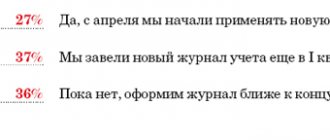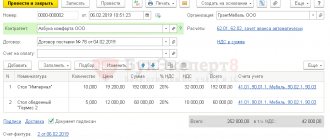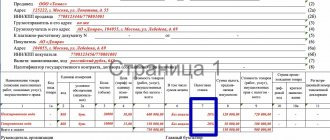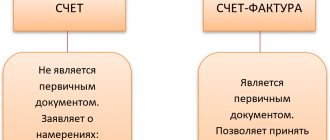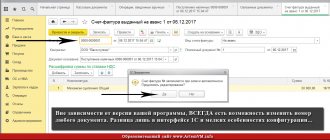Basic information about the document
An invoice is the documentary basis for accounting, calculation and deduction of VAT. An invoice is issued by the supplier - the VAT payer - to its customers: companies or entrepreneurs. In other words, any transaction for the sale of goods and services subject to VAT must be accompanied by the preparation of an invoice. For the buyer, this document serves as the basis for reducing his own VAT payable, that is, for a tax deduction.
If the buyer does not pay VAT, the supplier may not issue him invoices. However, to do this, an agreement must be signed between the parties that no invoices will be issued. Suppliers who do not pay VAT are also exempt from the need to prepare this document.
Regulatory regulation
The legal basis for the application of the document in question is the Tax Code. Paragraph 3 of Article 169 defines the cases in which an invoice is issued. This includes transactions that are subject to VAT, as well as the export of non-taxable goods from Russia to the territory of the Customs Union.
The document has a specific form, set out in Resolution No. 1137. The same act contains the rules in accordance with which invoices should be filled out. The form of the document and the procedure for filling it out are constantly being improved, and therefore changes are being made to the resolution.
Paper and electronic formats
Today, invoices are generated in the classic form, that is, on paper or in electronic format. Such an invoice, like its paper counterpart, must be drawn up in a strictly prescribed form and contain all the necessary details.
When is an electronic invoice issued? This is possible if the following conditions are met:
- an agreement has been concluded between organizations on the preparation of electronic invoices;
- counterparties have the technical ability to exchange documents in the established format via the Internet.
Otherwise there are no restrictions. An electronic document completely replaces a paper one, provided that it is drawn up in the form and certified with a digital signature.
Procedure and deadlines for issuing invoices in 2021
The period for issuing an invoice is 5 calendar days, counted from the date of the event in connection with which the invoice is issued (clauses 1 and 2 of article 6.1, clause 3 of article 168 of the Tax Code of the Russian Federation), that is:
- shipments;
- advance receipts;
- changes in the quantity or price of goods shipped.
Whether the day of shipment, receipt of advance payment, etc. is considered when determining this 5-day period, see here.
The Tax Code of the Russian Federation does not establish deadlines for issuing an invoice in other situations requiring its preparation.
In this case, as a general rule, an invoice is issued for each event separately, but it is also possible to draw up one document for all shipments made to one buyer during the day (letter of the Ministry of Finance of Russia dated May 2, 2012 No. 03-07-09/44). If the shipment is continuous (energy resources, rent), then the invoice, as well as the shipping document, can be issued once per month or quarter (letter of the Ministry of Finance of Russia dated September 13, 2018 No. 03-07-11/65642, dated 06/25/2008 No. 07-05-06/142 and dated 02/17/2009 No. 03-07-11/41).
In the first two cases (for shipment and advance payment), a regular invoice is drawn up, and in the third case (for a change in quantity or price), an adjustment invoice is drawn up.
To learn how the requirements for the form and rules for filling out an invoice have changed since 01/01/2019, read the material “New invoice from 01/01/2019: download the form”.
When is an invoice issued?
Most often, the primary document in question is issued by the seller when carrying out transactions that, in accordance with tax legislation, are subject to VAT. The sale of most goods and services, including gratuitous transfers, is subject to taxation. But there are exceptions - they are listed in Article 149 of the Tax Code of the Russian Federation.
Also, companies and individual entrepreneurs working with VAT are required to generate invoices upon receipt of payment for future shipments. Such documents are usually called advance invoices.
In addition, VAT payers are required to issue invoices when exporting to the EAEU countries.
There are cases when the paper is issued by an entity that does not pay VAT. Such an obligation arises for companies and individual entrepreneurs if they, on their own behalf, sell goods that belong to another organization - a VAT payer. We are talking about mediation activities under commission agreements and the like.
Providing character: what date to issue the act and invoice
In turn, tax accounting is carried out on the basis of data from primary documents, grouped in accordance with the procedure provided for by the Tax Code of the Russian Federation (Article 313 of the Tax Code of the Russian Federation). The basic rule for taking into account certain costs is set out in paragraph 1 of Art. 252 of the Tax Code of the Russian Federation: expenses must be economically justified, documented and aimed at generating income. In this case, documented expenses mean expenses confirmed by documents drawn up in accordance with the legislation of the Russian Federation.
In accordance with Part 1 of Art. 9 of the Federal Law of December 6, 2011 No. 402-FZ “On Accounting” (hereinafter referred to as Law No. 402-FZ), each fact of economic life is subject to registration as a primary accounting document. The primary accounting document must be drawn up when a fact of economic life is committed, and if this is not possible, immediately after its completion (Part 3 of Article 9 of Law No. 402-FZ). By virtue of Part 4 of Art. 9 of Law No. 402-FZ, the forms of primary accounting documents are approved by the head of the economic entity upon the recommendation of the official charged with maintaining accounting records. Mandatory details of primary accounting documents are listed in Part 2 of Art. 9 of Law No. 402-FZ.
The procedure for issuing a document during implementation
Let's consider a basic example - the seller releases the goods, and the buyer makes payment upon delivery. The invoice is issued within 5 days, starting from when the goods were shipped, services were provided or work was performed.
One copy of the invoice is issued for the supplier himself, the second for the buyer. The document must be registered in the Invoice Journal (hereinafter referred to as the Journal). In addition, the seller makes an entry in the Sales Book and indicates the details of the corresponding invoice. And the buyer, accordingly, makes a similar entry in his Purchase Book.
When is an advance invoice issued?
If the buyer makes an advance payment for a future delivery, the supplier must also issue an invoice. In this case, it does not matter whether the buyer made the payment in full or in part - the document is issued for the transferred amount. The seller charges VAT on the prepayment received, and the buyer, subject to certain conditions, can claim his input tax as a deduction.
When is an advance invoice issued? The issuance period is 5 days, calculated from the date on which the advance payment was received. The document is taken into account by the supplier in the following order:
- the advance invoice is reflected in the Sales Book;
- when the goods are sold, a shipping invoice, that is, a “real” invoice, is drawn up;
- the shipping document is noted in the Sales Book for the entire amount of delivery;
- at the same time, an entry regarding the advance invoice is made in the Purchase Ledger.
The buyer has a similar document accounting procedure, but with the opposite sign: instead of entries in the Purchase Book, there is a Sales Book, and vice versa. Both the buyer and the seller's documents are also subject to registration in the Journal.
Submission deadlines
The period for issuing an invoice is no more than five days, and the following must occur: full or partial payment for services or products, shipment of goods and materials, against future deliveries, and property rights are transferred. The account is maintained from the day that occurs after the day during which services were provided or sales were made.
If the cost has changed in the primary document, then fill out an adjustment invoice within five days from the date of first filling out the form. The buyer agrees to the price change, then financial transactions are carried out.
When an intermediary issues an invoice
Let us separately mention the peculiarities of working with invoices of commission agents and other intermediaries (agents, forwarders, attorneys). When selling the goods of the principal with VAT on his own behalf, the commission agent must draw up an invoice and highlight the amount of tax in it. This will allow the buyer to claim their input tax as a deduction. Moreover, an invoice should also be issued if the commission agent himself does not pay VAT, for example, being on a simplified taxation system. The fact is that in this case, the commission agent, being an intermediary between the buyer and the owner of the goods, actually takes on the latter’s function in calculating VAT and drawing up documents.
The commission agent registers the exposed document only in the Journal. The second copy is intended for the buyer. The commission agent transfers the document details to the principal, and he issues an invoice to the intermediary himself. In this case, the document must have the same number that the commission agent assigned to it. He notes the received invoice in the Journal.
If a commission agent buys goods from a third party for a VAT payer, he re-issues an invoice issued by the seller to his address. In this case, the received and issued invoices should also be recorded in the Journal without being reflected in the Books.
If the displayed document needs to be changed
In practice, it often happens that changes have to be made to documents. For example, there was a shortage of goods or its price changed. This is also required when an error is found in the invoice.
To change the information in the issued document, corrected and adjustment invoices are drawn up. The first is simply a new version of the document that contains the correct information. The corrected invoice is issued within three years from the period of issue of the original document. This is due to the right of the buyer to claim input tax deduction within a specified period. The corrected document exists independently and completely replaces the one in which the incorrect data was indicated. It is issued in cases where it is necessary to correct an error that did not lead to a change in the amount. For example, the supplier incorrectly indicated the buyer's name or tax rate. If incorrect information in the invoice does not make deduction impossible, then a corrected document does not need to be drawn up.
In what cases is a correction invoice issued? When the transaction amount is adjusted, for example, due to a change in the cost of the product. In this case, an agreement must be concluded between the parties to change the amount (annex to the agreement, act, decision). The adjustment document is drawn up for the amount of changes and is an addition to the original one.
It happens that the supplier sold several batches of goods to one buyer and issued a separate invoice for each. However, it happened that the amount in all deliveries needed to be changed. How many invoices are issued for adjustments? In this situation, there is no need to draw up several documents - the seller can draw up one for all changes addressed to this buyer.
Nuances
Even if several shipments of goods were delivered to one person over five days (without interruptions in supply), this document is provided once. This means that within five days from the first shipment, one invoice can be drawn up (if daily deliveries are made to one person).
If the goods are shipped before payment has been made, the document is provided within five calendar days from the date of shipment of the goods. The date of transfer of ownership does not matter.
For services performed, an invoice must be presented after they have been performed (except in cases of advance payment from the purchasing company)
Since the timing of the invoice is not particularly important for suppliers, sometimes sellers issue it at the time of signing the contract. Well, early receipt of the completed form will not affect the deduction of VAT.
Violation of rules and responsibility
What are the risks for a company or individual entrepreneur for violations related to the described document? The law stipulates the deadlines for issuing an invoice, but does not provide for direct liability for exceeding them. But the absence of an invoice is regarded as a serious flaw in accounting. Absence means failure to issue a document in the quarter in which the transaction took place.
For this, the taxpayer may be punished in accordance with Article 120 of the Tax Code of the Russian Federation. If this violation is detected for the first time, the organization may receive penalties in the amount of 10 thousand rubles. If the absence of invoices is revealed in several quarters, the amount of the fine will triple. And in the case where this violation led to an understatement of tax, the fine will be 1/5 of the amount of the underpayment, but not less than 40 thousand rubles.
It must be said that it is quite difficult to “forget” about an invoice when selling a product or service. Even if this happens, the buyer will definitely remind him of the need to draw up a document, because without it he will not be able to deduct VAT. With an invoice for an advance payment, everything is different. Buyers do not always claim VAT deduction from the advance payment, so they do not ask for an invoice. In such a situation, some accountants do not consider it necessary to issue them. They reason like this: receipt of the advance and shipment occur in the same quarter (in most cases), so why issue an interim document? However, the Federal Tax Service considers this a violation if more than five days pass between the receipt of the advance payment and the shipment of the goods.
Why is it important to follow the design?
The document to which this article is devoted is necessary for the buyer to claim VAT deduction. If critical errors are made in it, the tax service will not recognize the deduction. This means that the company will have to pay additional taxes, and in the worst case, also pay a fine. Therefore, when receiving an invoice, it is important to carefully check its basic details.
To be fair, we note that not every mistake will result in a denial of the deduction. There are a number of transaction parameters that must be identified by the invoice, namely:
- buyer and seller;
- object of the contract;
- cost of goods (services) or advance payment amount;
- VAT rate and amount.
If the specified parameters are determined from the invoice, then a deduction can be claimed on it, despite other errors. Having received a refusal from the Federal Tax Service, the taxpayer can safely go to court. However, if the supplier made an error when generating the invoice, for example, in the cost of the goods or the amount of tax, then the buyer may not count on VAT preferences.
So, an invoice is very important for calculating VAT from the supplier and deducting its incoming part from the buyer. It is necessary to monitor the current form of the document, because it changes periodically. And it is extremely important to follow the procedure and deadlines for its preparation, as well as to avoid critical errors that will lead to non-recognition of the deduction from the buyer.
Registration requirements
Main information:
- List of services provided and products issued.
- Details and names of participants in the transaction.
- Designation of prices for all items.
- Full cost, rate and tax amount.
By mutual agreement of the parties, a decision is made on what form to submit the documentation (paper or electronic).
The following documents are required to be drawn up:
- all those who pay VAT in transactions that are subject to taxation;
- tax agent - for the service provider;
- those who use their VAT exemption under Article 145 of the Tax Code of the Russian Federation.
Also in these categories there may also be intermediaries who pay taxes in accordance with the general regime, with the simplified tax system or other special payment regime.
These documents should not be completed:
- entrepreneurs and firms engaged in retail trade, catering or providing services to the public for cash (with supporting documents);
- those who carry out tax-free transactions;
- those who pay taxes under special regimes (with certain exceptions);
- if an advance has been received for future supplies of industrial materials, and the production cycle is long;
- persons who entered into a transaction in the sale of goods and services and do not pay or are exempt from VAT (taxable - 0% rate, non-taxable - in accordance with Article 149 of the Tax Code).
Due to errors when filling out the form, the tax office may withdraw the deduction and the tax amount will be increased. We are talking about the following errors:
- Errors that make it impossible to determine the name of the purchased product or service.
- Those errors or distortions that make it impossible to determine information about the seller and buyer.
- If it is impossible to see the VAT rate for the product.
- If it is impossible to determine the amount of tax fees.
- If there are errors in determining the price of services or goods, or in the prepayment.
There are rules for numbering an invoice:
- The number is recorded in accordance with chronology and in ascending order.
- It is indicated in the first line.
- The numbering is supplemented with the help of digital indexes through “/” if the document was compiled by trustees or separate divisions.
- Renewal of numbers is at the discretion of the company.
